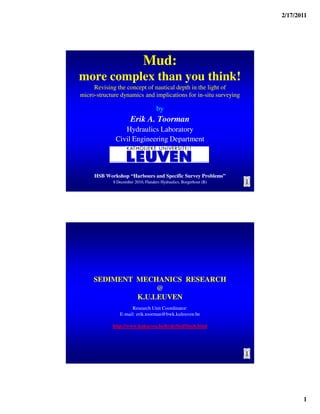
Nautical bottom2010b
- 1. 2/17/2011 Mud: more complex than you think! Revising the concept of nautical depth in the light of micro- micro-structure dynamics and implications for in-situ surveying in- by Erik A. Toorman Hydraulics Laboratory Civil Engineering Department HSB Workshop “Harbours and Specific Survey Problems” “Harbours 8 December 2010, Flanders Hydraulics, Borgerhout (B) SEDIMENT MECHANICS RESEARCH @ K.U.LEUVEN Research Unit Coordinator: E-mail: erik.toorman@bwk.kuleuven.be http://www.kuleuven.be/hydr/SedMech.html 1
- 2. 2/17/2011 Understanding “mud” and its behaviour under shear Defining Mud Mud is a mixture of water and fine sediments (clay, silt and sand) and organic matter, which behaviour is characterized as cohesive, when it is dominated by the clay fraction (>15%). 2
- 3. 2/17/2011 Mud particles Formed by flocculation = aggregation (+ break-up) in a suspension after Krone © van Leussen (1993) Mud layer micro-structure after Partheniades 3D network structure for ρ > 1100 kg/m3 (gel point) “card house” © van Olphen primary kaolin particles (SEM image) 3
- 4. 2/17/2011 Micro-structure in mud-sand mixture Clay bridges glue the sand skeleton Scanning-electron microscopy images (left: air-dried – right: oven dried) © KULeuven (Torfs , PhD, 1995) “Fluid” Mud = “dense”, flocculated suspension with concentration (slightly) above the gel point (i.e. the structure formation threshold) (soil at rest liquefied when sheared) Mud rheology = macroscopic description of its deformation and flow behaviour Time-dependence due to (micro-)cracks and restructuring 4
- 5. 2/17/2011 Experimental equilibrium flow curve total viscous SHEAR STRESS (Pa) retained SHEAR RATE (s-1) bentonite suspension (9.91% by weight) Weissenberg Rheogoniometer + parallel plates (Wright & Krone, 1989) Experimental mud viscosity “Shear thinning” Apparent viscosity for River Parrett (UK) mud at different densities Carri-Med CS rheometer data by Jones & Golden (1990) 5
- 6. 2/17/2011 Thixotropy: conceptual Barnes (J. Non-Newtonian Fluids, 1997) Thixotropy Time-dependent behaviour under shear of dense flocculated suspensions: – structural break-down when sheared (liquefaction), – structural recovery at rest (aggregation). (+ self-weight consolidation) 6
- 7. 2/17/2011 Thixotropy @ microscale Complex floc motion and interaction during simple shear flow in a 2D dispersion of PS particles at decane/water interface Masschaele & Vermant (2008) Thixotropy @ macroscale Placement of ADV instruments on mud bank along the Surinam coast © Hydraulics Laboratory, KULeuven 7
- 8. 2/17/2011 Measurement: Rheometry “Shear-rate-step-change” experiment Surinam Coast mud (diluted to ρ = 1130 kg/m3 ) 100 90 80 60 70 30 12 Viscosity(%) 60 6 3 50 1.5 0.6 40 0.3 30 20 10 0 17:16:48 17:24:00 17:31:12 17:38:24 17:45:36 17:52:48 Tim e(hh:m m :ss) Brookfield rotoviscometer + vane spindle Equilibrium flow curve: Bingham 8 7 TOTAL STRESS SHEAR STRESS (Pa) 6 5 4 3 2 RESIDUAL STRESS 1 0 0 20 40 60 80 100 120 140 SHEAR RATE (s-1) ρ = 1130 kg/m3 – after shear rate correction 8
- 9. 2/17/2011 Rheological models 2.5 SHEAR STRESS / BINGHAM YIELD STRESS 2 Worrall-Tuliani Bingham 1.5 Herschel-Bulkley µ = τ / γ& 1 0.5 “true” yield stress Newtonian effective viscosity shear thinning 0 0 10 20 30 40 50 60 70 80 90 100 SHEAR RATE (s-1) Thixotropy Model (Toorman, 2005) • Constitutive equation: τ (λ , γ& ) = (µ ∞ + λη 0 )γ& + λτ 0 λ = µ ∞ γ& + τ 0 λe • Structural kinetics (1st order): dλ = a (γ& )(1 − λ ) − b(γ& )λγ& dt 1 • with: λe (γ& ) = and β = b / a = η0 /τ 0 1 + βγ& 9
- 10. 2/17/2011 Fluid mud rheology constant structure curves equilibrium flow curve bentonite data Cheng & Evans (1965) Fluid mud rheology hysteresis hectorite data Joye & Poehlein (1971) 10
- 11. 2/17/2011 Implications for the definition of Nautical Bottom Navigability • Thickness & viscosity of disturbed mud = function of speed & ac-/deceleration • Drag force unevenly distributed disturbed mud • Interface between disturbed and undisturbed = artificial (and temporal!) “rheological transition” 11
- 12. 2/17/2011 CFD of drag on a ball in a Bingham fluid 12
- 13. 2/17/2011 Implications for surveying Problems • Intrusive instruments (profiling or towed) disturb the original microstructure. • The degree of disturbance is determined by the speed of intrusion and the size and shape of the device • No equilibrium data can be obtained • Usually the device moves too fast such that the structure is cut and not truly sheared 13
- 14. 2/17/2011 Conclusions Conclusions (1) • Mud is a thixotropic gel (a “structured” fluid). • Its instantaneous strength and apparent viscosity depend on its micro-structure. • A rheological transition indicates a discontinuity in micro-structure (i.e. in history). • The state of the micro-structure requires knowledge of the shear history. • The actual nautical depth depends thus also on the state of the mud layer (which varies along the ship!) and the shear history caused by the movement of the ship and that of previous passages. 14
- 15. 2/17/2011 Conclusions (2) • Nautical depth cannot be defined in terms of rheological parameters (and composition) alone! • It also depends on the manoeuvre and ship characteristics. • Mud rheology can be characterized by dedicated laboratory experiments. • A rheological closure for CFD applications is available. • 3D CFD studies are needed to understand the problem of nautical depth for each ship. Thank you Questions? E-mail: erik.toorman@bwk.kuleuven.be SELECTED PUBLICATIONS Berlamont, J., Ockenden, M., Toorman, E. & Winterwerp, J. (1993). The characterisation of cohesive sediment properties. Coastal Engineering, Vol.21:105-128. Toorman, E.A. (1996). Sedimentation and self-weight consolidation: general unifying theory. Géotechnique, Vol.46(1):103-113. Toorman, E.A. (1998). Sedimentation and self-weight consolidation: general unifying theory. Discussion. Géotechnique, Vol.48 (2):295-298. Toorman, E.A. (1997). Modelling the thixotropic behaviour of dense cohesive sediment suspensions. Rheologica Acta Vol.36 (1):56-65. 15
